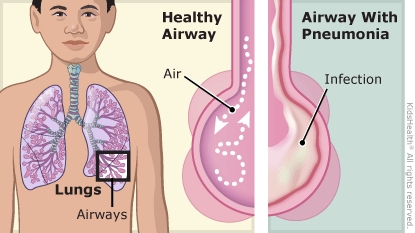Pneumonia is an infection in the airways of the lungs. It is caused by different types of germs, such as viruses or bacteria. Your child's pneumonia was caused by a virus. Most kids with viral pneumonia feel better within a week, but the cough may continue for a few weeks. Help your child get better by following these care instructions.



Your child:

Your child:
Call 911 if your child is struggling to breathe or turns blue.

How is viral pneumonia diagnosed? To diagnose viral pneumonia, health care providers look at a child's age and symptoms such as fever, chest pain, and wheezing. Sometimes they test the mucus inside the nose for viruses or do a chest X-ray.
What happens in viral pneumonia? If a virus — such as influenza (flu), parainfluenza, adenovirus, coronavirus, or respiratory syncytial virus (RSV) — gets in the lungs, the airways swell and get irritated. They also fill with white blood cells (germ-fighting cells) and mucus. This blocks the airways and leads to coughing and sometimes breathing problems.
How is pneumonia spread? The germs that cause pneumonia can spread through coughing and sneezing, when someone touches the germ then touches their mouth, nose, or eyes, or by sharing a drinking glass or eating utensil.
To help prevent the spread of germs: